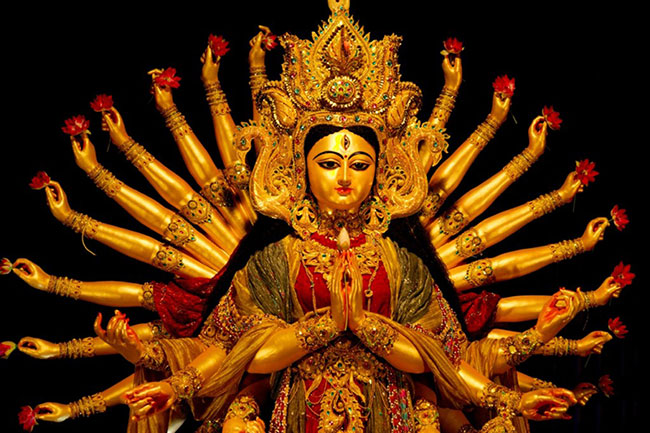If your child asks you what Vijaya Dashami actually symbolize, you will have a simple answer to it. You will tell them its celebration of victory over evil. If there are more questions you will even sit down and tell your children the story of how Durga defeated the Mahisasur, the demon. In every house there is a tradition of keeping Jamara on Gatasthapana day and that is something of a curiosity. If your children are inquisitive you might end up with lots of questions. You might even have to explain the terms used in the stotra you recite everyday during Dashain: Prathamam Shailputri cha dwitiyam Brahmacharini, tritiyam Chandraghateti, Kushmandeti chaturthkam, panchamam Skandamateti, shashtham Katyayinicha,saptamam Kalratriti, Mahagouriti chashtamam, navamam Siddhidatri cha Navadurga prakirtitah.
Yes I know, you have already explained to them that these are all different manifestations of Devi Parvati. Then again we never asked our parents the significance of Nava Durga and the identity of different Devis mentioned in the stotra. We just memorized it and remembered it every Dashain. Well children of today are different. They want to know everything and parents need to be on top of things and be prepared to answer their questions. Yes the internet is there to help but its fun to hear from the parents. I explained to my sons every time they asked me about it and they enjoyed hearing about it too. So here you go. I will try and make it a bit easier for you.
So when we do your Ghatasthapana the first deity we worship is Maa Durga in the form of Shailaputri. The first name in the stotra is Devi Shailputri. If you even remotely remember your Sanskrit, Shail means “the mountain” so she is the daughter of mountain. After self-immolation of Her form as Sati, Mother Goddess took birth as the daughter of Lord Himalaya.
The second day we worship Maa Durga in the form of Devi Brahmacharini: the Mother Goddess born as Daksha Prajapati’s, daughter Sati: born to marry Shiva. Sati in unmarried form is worshipped as Brahmacharini.
On the third day we worship Devi Chandraghanta: Goddess Chandraghanta is the married form of Shailputri and Mahagauri. After getting married to Shiva, Goddess Mahagauri started decorating her forehead with a half moon (Chandra) shaped like a bell (Ghanta). So she came to be known as Goddess Chandraghanta.
The fourth day is devoted to worshipping Devi Kushmanda. After taking the form of Siddhidatri, the Mother Goddess started living within the Sun and liberating the Sun’s energy to the universe. Since then, this form of the Goddess is known as Kushmanda: for her power and capability to live inside the Sun. She gets the glow and radiance for luminous body from the Sun.
Non-violence rally against animal sacrifice

With many people away from t heir home land, the fun part is going to be missed in many households.
On the fifth day we worship Devi Skandamata: In her form as mother of the God of War, Lord Skanda (Kartikeya). Hence she is also known as Goddess Skandamata.
On the sixth day we worship Devi Katyayani—to destroy Mahishasura, the Maa Durga takes the form of Goddess Katyayani: one of the violent forms as she manifests as a warrior Goddess.
On the seventh day she takes the form of Devi Kalaratri. This is the fiercest and the most ferocious form of the Mother Goddess, in which she destroys the demons, Sumbha and Nisumbha.
On the eighth day we worship Devi Mahagauri. As Hindu mythologies have it, the Goddess Shailputri at the age of sixteen was extremely beautiful and had a very fair complexion. Hence she was known as Goddess Mahagauri.
On the ninth day we worship Devi Siddidhatri. This is the form of Maa in the beginning of the universe. This is the form Lord Rudra worshipped in the un-manifested form of Maa (Adi Parashakti) for creation. As Adi Parashakti, Maa was pure energy and had no form. She attained a form when she appeared from the left side of Shiva as Siddhidatri. Now that you know, it will be much easier to explain to children about the different forms of Maa Durga.
All these are the nine forms of Durga and they are worshipped during the nine days of navaratri. On the tenth day is Vijayadashami. This is the day Maa Durga killed Mahisasur and we celebrate the victory of good over evil.

IMNEPAL.COM
This is very much what we have heard from generation and generations and will be heard for generations to come. The one thing that will change with it is how and with whom it is celebrated. Yes the tika and jamara will remain I hope, but the reasons for adorning it might change. Children will still badger for new clothes and dakshina and the older people will still sit and play cards. I remember as a child my cousin sister and I would visit everyone in the village for Dashain tika and dakshina. All we cared for was dakshina so we could play cards in the evening. Now times have changed and parents are left alone to celebrate various festivals with memories of old times to cherish with.
Finally, with so many people being away from home this fun part is surely missing in majority of the Nepali homes. I am sure just like our home, others are also feeling the same way. There are only parents celebrating Dashain this year. The younger generation in the family is missing. I am sure all of us feel that next year it will be different, we will all be at one place to celebrate Dashain. We all know it’s a wishful thinking and that it will be the same as this year. Then again we can always hope for good times to come. That much we can afford to believe, right?
The author is an educationist and author of several children’s books





































